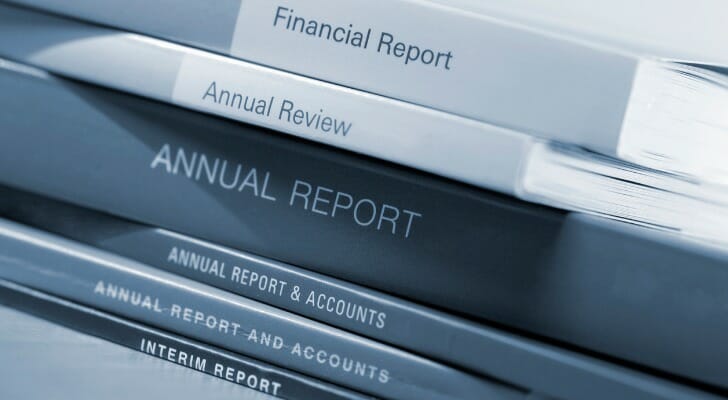 If you invest in stocks then you’ve probably received an annual report in the mail at least once. While you may be tempted to toss it out, it’s worth taking the time to read through it to better understand the company you’ve invested in. These reports, filed with the Securities and Exchange Commission (SEC) each year, typically describe the company’s operations and finances (balance sheet, income statement, and cash flow statement), as well as management’s discussion and analysis of the company’s activities and prospects. Annual reports can be helpful when making decisions about what to invest in or when to sell investments you already own.
If you invest in stocks then you’ve probably received an annual report in the mail at least once. While you may be tempted to toss it out, it’s worth taking the time to read through it to better understand the company you’ve invested in. These reports, filed with the Securities and Exchange Commission (SEC) each year, typically describe the company’s operations and finances (balance sheet, income statement, and cash flow statement), as well as management’s discussion and analysis of the company’s activities and prospects. Annual reports can be helpful when making decisions about what to invest in or when to sell investments you already own.
What Is an Annual Report?
An annual report is essentially a summary of a publicly traded company’s performance and progress for the previous year. It is sent to investors ahead of the company’s annual meeting, in which shareholders elect directors.
Companies are required to submit a form 10-K to the SEC each year, which can be a lengthy document running several hundred pages long. This form can double as a company’s annual report or they may use it to create a shorter version for distribution among shareholders and investors. The annual report can also be distributed to prospective lenders if a company is interested in borrowing money to meet its capital needs.
Reading an annual report can give you insight into the financial health of a company; what its objectives are; how well it’s doing with meeting those objectives; and what activities the company is engaged in on the governance side. If a company issues both an annual report and a separate 10-K filing, you could choose to read both. But between the two, the annual report may be more condensed and easier to understand.
What’s In a Company’s Annual Report?
Annual reports tend to follow the same structure when it comes to the information they contain. Here’s what you can expect to see included in an annual report:
- CEO letter to the shareholders
- Background information on the company’s structure
- Company mission statement and vision
- Key operational and financial highlights
- Management discussion and analysis
- Financial statements for the company
- Corporate governance information
Annual reports can incorporate graphics, including charts or images, to better explain the information they contain.
How to Read an Annual Report

If you’ve received an annual report in the mail or via email, it helps to know how to read it. A good place to start is with the CEO’s letter to shareholders.
This letter typically outlines the key points to know about a company’s gains or losses for the previous year, any challenges or problems the company encountered and what the company’s business plans are heading into the next year. This is usually one of the shortest sections of the annual report but it’s a good warm-up for what comes next.
If you’re not well-versed in what a company does or what it’s all about, you can read through the sections describing its background and mission. This can tell you more about a company’s products and services, who it serves and what makes the company unique within its industry. You may want to take a closer look at this section if you’re researching a company that you’re thinking of investing in.
Next, look for a summary section detailing what the company has achieved over the last five to 10 years. This can give you an idea of how a company’s growth has trended over time.
From there, you can move on to the management discussion and analysis. This section is where the company’s management team chimes in on the most visible trends they’ve noticed. It’s important to keep in mind that these are opinions but they can be useful in gauging how management feels about where the company has been and where it’s headed next.
You can also look closely at the company’s holdings, its approach to sales and marketing and the risk assessment. This section details the general and specific risks that could affect how the company performs over time. Reading the risk assessment can help you better identify how a company fits your own risk tolerance as an investor.
Understanding Company Financials
One of the most important aspects of an annual report deals with a company’s financial health. Inside the report, you should see key financial statements, including:
- Income statements
- Cash flow statements
- Balance sheet
It’s important to look over these carefully because they can tell you a lot about how financially sound a company is. The income statement and balance sheet, for instance, can tell you how profitable a company is based on the returns it generates. You can also see what the company has in terms of assets and liabilities, and how the two compare.
The cash flow statement lets you see how cash moves in and out of the company and where it’s spending its money. This can give you a clue as to whether a company is focusing on paying down debt or investing money in expansion.
Aside from these financial statements, you may also find notes to the financial statements included at the end of this section in the annual report or in an appendix. It’s easy to skip over them but reading the notes can shed more light on a company’s financial state if they include or expand on information that wasn’t detailed in the income statement, cash flow statement or balance sheet.
Why Bother Reading an Annual Report?
Reading a company’s annual report can help you better understand what you own if you’re already invested or help you make a more informed decision about whether to invest in a particular company. For example, the report can tell you:
- How efficiently a company is managing its debts
- How profitable it was year over year
- What the company’s growth trajectory looks like and how it’s trending
- What a company is spending to cover operational expenses versus what it’s generating in revenues
The annual report can also reveal potential red flags that may suggest a company isn’t as stable or as profitable as it may seem. Comparing things like the actual earnings to adjusted earnings or the company’s branding and messaging year over year can give you hints as to how consistent it is in pursuing its objectives and what kind of success is really being achieved. Likewise, major swings in cash flow or a steep jump in debt levels year-over-year could suggest the company may be experiencing financial difficulties.
The Bottom Line
 Annual reports can be eye-opening, and as an investor, it’s a helpful way to better know the companies you’re putting your money behind. Once you get familiar with the structure of annual reports, it can be easier and less time-consuming to read them. Knowing what to focus on can also make it easier to perform apples-to-apples comparisons between similar companies as you pick and choose which stocks to include in your portfolio.
Annual reports can be eye-opening, and as an investor, it’s a helpful way to better know the companies you’re putting your money behind. Once you get familiar with the structure of annual reports, it can be easier and less time-consuming to read them. Knowing what to focus on can also make it easier to perform apples-to-apples comparisons between similar companies as you pick and choose which stocks to include in your portfolio.
Tips for Investing
- Many financial advisor will use annual reports and other essential information to assess potential invstment opportunities for your portfolio. If you don’t have a financial advisor yet, finding one doesn’t have to be difficult. SmartAsset’s free tool can match you with financial advisors in your local area in five minutes. If you’re ready to be matched with local advisors who can help you achieve your financial goals, get started now.
- In addition to annual reports, it is a good idea to check the earnings guidance of companies you invest in or are considering investing in. Earnings guidance generally includes financial statements and business goals. Just remember: these are projections, not predictions.
Photo credit: ©iStock.com/nortonrsx, ©iStock.com/LanaStock, ©iStock.com/peepo